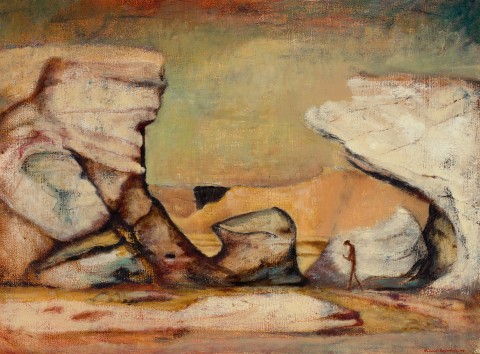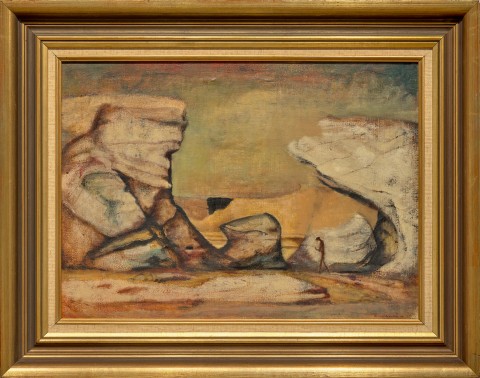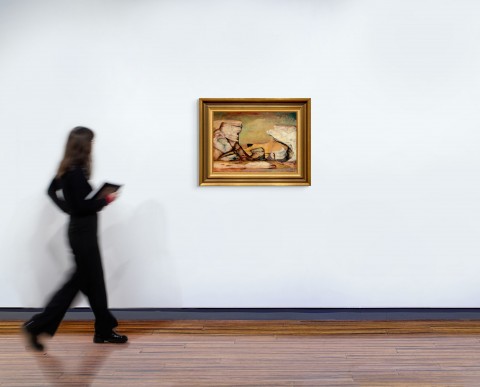THE FOSSICKER, 1949
RUSSELL DRYSDALE
oil on canvas
40.5 x 56.0 cm
signed and dated lower right: Russell Drysdale 49
Macquarie Galleries, Sydney (label attached verso)
Mrs Ivan Lewis, New South Wales, acquired from the above in 1949
Macquarie Galleries, Sydney
Dr D. R. Sheumack, Sydney, acquired from the above in 1964
Thence by descent
Private collection, Melbourne
Deutscher~Menzies, Melbourne, 22 November 1998, lot 282 (as ’The Fossickers’)
The Cbus Collection of Australian Art, Melbourne
Deutscher and Hackett, Melbourne, 27 July 2022, lot 28
Private collection, Hong Kong
Russell Drysdale, 1948 /1949, Macquarie Galleries, Sydney, 23 March – 4 April 1949, cat. 8
The D. R. Sheumack Collection of Australian Paintings, S. H. Ervin Museum and Art Gallery, Sydney, 17 May – 12 June 1983, cat. 27
Russell Drysdale Paintings 1940 – 1972, S. H. Ervin Museum and Art Gallery, Sydney, 14 June – 21 July 1985, cat. 26
The Artists of Hill End, Art Gallery of New South Wales, Sydney, 29 July – 17 September 1995, and touring, cat. 23 (label attached verso)
The Modern Landscape 1940 –1965, Heide Museum of Modern Art, Melbourne, 10 March – 3 May 1998
Russell Drysdale: Defining the Modern Landscape, TarraWarra Museum of Art, Victoria, 9 October 2013 – 9 February 2014
on long term loan to Bendigo Art Gallery, Victoria
‘Big Crowd at Drysdale Exhibition’, The Sydney Morning Herald, Sydney, 24 March 1949, p. 9
Klepac, L., The Life and Work of Russell Drysdale, Bay Books, Sydney, 1983, pl. 96, pp. 280 (illus.), 367
Christie, R., and Miller, J., (eds.), The D. R. Sheumack Collection. Eighty Years of Australian Painting, Sotheby’s Australia, Sydney, 1988, cat. 102, n.p. (illus.)
Wilson, G., The Artists of Hill End, The Beagle Press and Art Gallery of New South Wales, Sydney, 1995, pl. 23, pp. 45, 50 (illus.), 118
Fox, P., The Modern Landscape 1940 – 1965, Museum of Modern Art at Heide, Victoria, 1998, pp. 6 (illus.), 8
Nainby, B., Stanhope, Z., and Furlonger, K., The Cbus Collection of Australian Art, in association with Latrobe Regional Gallery, Melbourne, 2009, pp. 15, 17, 77 (illus.), 218
Heathcote, C., Russell Drysdale: Defining the Modern Landscape, TarraWarra Museum of Art, Victoria, 2013, pp. 22 (illus.), 23, 85
8323##M.jpg
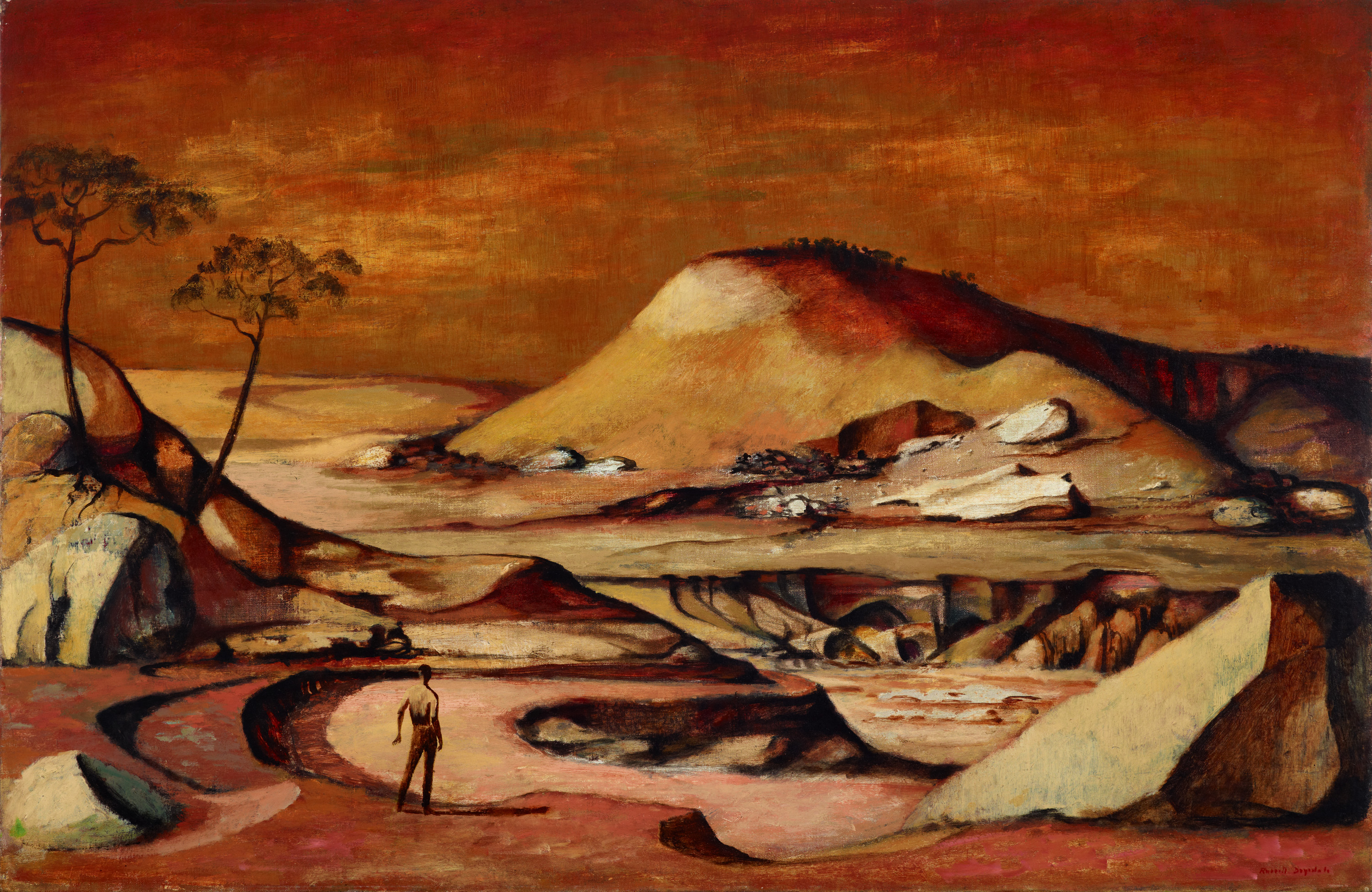
‘When a vision becomes as widespread throughout society as Drysdale’s has in contemporary Australia, it is hard to believe that it has not always been there. It is now difficult to view Australian landscape without an echo of Drysdale’s images. His vision has become an integral part of the world in which we live.’1
Alongside renowned painters including Arthur Streeton and Fred Williams, Russell Drysdale is an artist whose imagery has become synonymous with Australia, instantly recognisable and powerfully evocative. Drysdale might easily have followed in his father’s footsteps however, and established a career working on the land, had it not been for eye surgery in 1932 and a fortuitous meeting with Julian Smith – ‘that strange and brilliant mixture of surgeon, artist and photographer.’2 Smith was impressed by drawings Drysdale made while recuperating and showed them to Daryl Lindsay – artist and later, Director of the National Gallery of Victoria – who recalled that they ‘showed a curious sensitivity and a sharp observation.’3 The young Drysdale ‘liked Lindsay because he had had the same sort of life that I had led… He had been a jackeroo [sic] and a station manager and we could talk about horses and sheep.’4 A subsequent introduction to George Bell, the influential modernist artist and respected teacher, sealed Drysdale’s fate, and in 1935 he enrolled in formal art studies at the Bell-Shore School in Melbourne.
Drysdale’s first solo exhibition at Melbourne’s Riddell Galleries in 1938 was well received, the Herald critic observing that he was a ‘natural painter savouring to the full the exciting discovery of paint.’5 His artistic trajectory continued to rise and in 1941, in addition to being represented in an exhibition of Australian art which toured America and Canada, Monday morning, 1938 was acquired by the Metropolitan Museum of Art in New York. In 1942, both the National Gallery of Victoria and the Art Gallery of New South Wales purchased paintings for their permanent collections, and the Art Gallery of South Australia followed suit the next year.
RUSSELL DRYSDALE.jpg
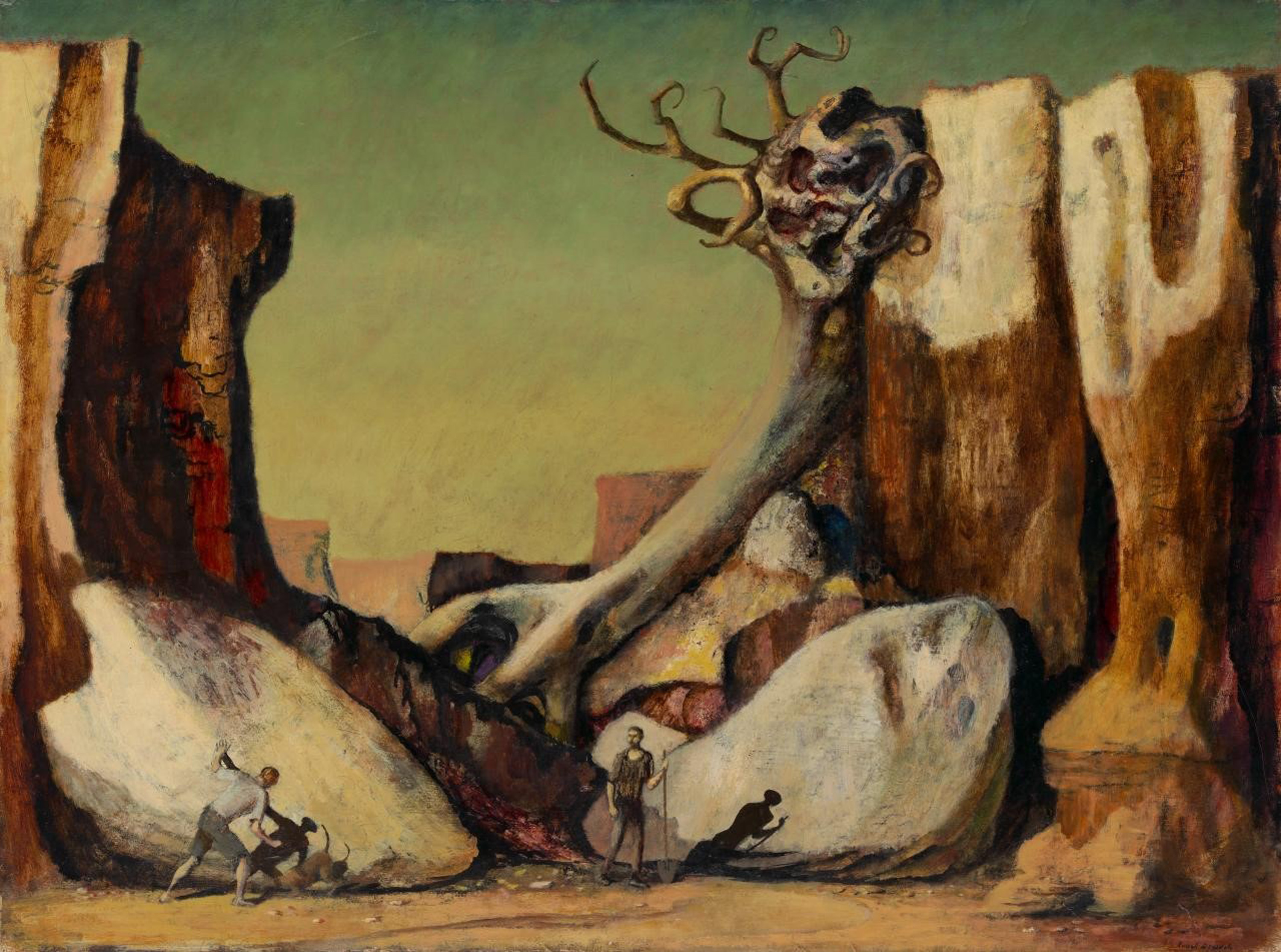
Early paintings such as Man feeding his dogs, 1941 (Queensland Art Gallery ǀ Gallery of Modern Art) clearly show the feeling and familiarity that Drysdale had for rural subjects, as well as his ability to express this in paint. A commission in 1944 to accompany writer Keith Newman through western New South Wales and record the devastating effects of the drought for the Sydney Morning Herald, added another dimension. This experience expanded Drysdale’s visual repertoire with images and motifs which depicted the country in such an extreme state that it appeared surreal and otherworldly. In subsequent paintings, a palette of rich ochres and black echo the parched landscape, while the dead trees, animal carcasses and remnants of human habitation provide graphic reminders of its harshness. As Newman wrote, ‘The dust-laden air plays eerie tricks with light. The sky appears leaden… crossed by great bands of black, red and grey… The sun is entirely obscured or shows like a wan full moon. Dead trees… loom through the hot murk in a variety of fantastic shapes as though they died in agony beneath the axe or tortured by thirst as the wind below the soil from their roots… Worse than the skeletons of animals are the skeletons of homes.’6
The impact of this drought-stricken landscape was profound and continued to influence Drysdale’s imagery for years to come. Similarly influential was Hill End, a once prosperous gold mining town north-west of Bathurst, which he first visited with fellow artist, Donald Friend, in 1947. As Friend recorded in his diary, the town was ‘an old, ruined village living on the memory of its former fifty thousand inhabitants and fabulous tales of gold strikes. Now there are only a handful of rather sordid, jovial mad peasants who live by fossicking and rabbiting.’7 Working from sketches and the many photographs he took, Drysdale found imagery and atmosphere in Hill End. The latter in particular feeds into the quiet emptiness that characterises many of his paintings – think for example of the now iconic 1947 work, The rabbiters (National Gallery of Victoria). The fossicker, 1949 exemplifies this feeling, the monumentality of the ancient rocky forms towering over a lone figure, signaling nature’s grandeur and strength. Drysdale’s technique of building up the painting with various layers of scumbling and glazing creates a rich patina, adding to the visual drama of the scene which contrasts bright sunlight with areas of deep shadow.
The fossicker was first shown in Drysdale’s 1949 solo exhibition at Macquarie Galleries, Sydney, alongside eleven other paintings including portraits of friends and fellow artists, Margaret Olley and Donald Friend. According to the Sydney Morning Herald, the opening was a lively affair, ‘crowded out… by artists and others… [and] celebrated with a sherry party at noon.’8 It was also an immediate success and ‘Before one o’clock a red seal was on every picture available for sale.’9
1. Klepac, L., Russell Drysdale, Bay Books, Sydney, 1983, p. 105
2. Joseph Burke, cited in Klepac, ibid., p. 15
3. ibid.
4. Drysdale interviewed by Geoffrey Dutton, cited in Eagle, M. and Minchin, J., The George Bell School: Students, Friends, Influences, Deutscher Art Publications, Melbourne and Resolution Press, Sydney, 1981, p. 91
5. Burdett, B., Herald, Melbourne, 27 April 1938, cited in Klepac, Russell Drysdale, Murdoch Books, Millers Point, 2009, p. 54
6. Newman, K., ‘An artist’s journey into Australia’s “lost world”’, Sydney Morning Herald, 16 December 1944, p. 5 cited in Smith, G., Russell Drysdale 1912 – 81, National Gallery of Victoria, Melbourne, 1997, p. 84
7. Friend, D., diary entry, 22 August 1947, cited in Klepac, op. cit., p. 89
8 ‘Big Crowd at Drysdale Exhibition’, Sydney Morning Herald, Sydney, 24 March 1949, p. 9
9. ibid.
KIRSTY GRANT
